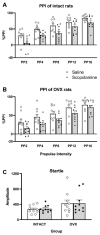The Impact of Removal of Ovarian Hormones on Cholinergic Muscarinic Receptors: Examining Prepulse Inhibition and Receptor Binding
- PMID: 32079174
- PMCID: PMC7071400
- DOI: 10.3390/brainsci10020106
The Impact of Removal of Ovarian Hormones on Cholinergic Muscarinic Receptors: Examining Prepulse Inhibition and Receptor Binding
Abstract
Ovarian hormones, such as estrogens and progesterone, are known to exert beneficial effects on cognition and some psychiatric disorders. The basis of these effects is not fully understood, but may involve altered cholinergic neurotransmission. This study aimed to investigate how a lack of ovarian hormones would impact muscarinic receptor-induced deficits in prepulse inhibition (PPI) and muscarinic receptor density in several brain regions. Adult female rats were either ovariectomized, to remove the source of ovarian hormones, or left intact (sham-operated). PPI is a measure of sensorimotor gating that is typically impaired in schizophrenia patients, and similar deficits can be induced in rats by administering scopolamine, a muscarinic receptor antagonist. Our results revealed no significant effects of ovariectomy on PPI after saline or scopolamine treatment. Autoradiography was performed to measure cholinergic muscarinic receptor binding density using [3H]-pirenzepine, [3H]-AF-DX, and [3H]-4-DAMP, to label M1, M2/M4, and M3 receptors, respectively. We examined the amygdala, caudate putamen, dorsal hippocampus, motor cortex, retrosplenial cortex, and ventromedial hypothalamus. There were no significant group differences in any region for any muscarinic receptor type. These results suggest that removing peripheral ovarian hormones does not influence the cholinergic muscarinic receptor system in the context of PPI or receptor binding density.
Keywords: CHRM1; PPI; female; ovariectomy; rat; schizophrenia.
Conflict of interest statement
The authors declare no conflict of interest. The funders had no role in the design of the study; in the collection, analyses, or interpretation of data; in the writing of the manuscript; or in the decision to publish the results.
Figures



References
-
- Dohanich G. Ovarian steroids and cognitive function. Curr. Dir. Psychol. Sci. 2003;12:57–61. doi: 10.1111/1467-8721.01226. - DOI
-
- Sbisa A.M., van den Buuse M., Gogos A. Psychiatry and Neuroscience Update-Vol. II. Springer; Berlin/Heidelberg, Germany: 2017. The Effect of 17β–Estradiol and Its Analogues on Cognition in Preclinical and Clinical Research: Relevance to Schizophrenia; pp. 355–374.
Grants and funding
LinkOut - more resources
Full Text Sources
Molecular Biology Databases

